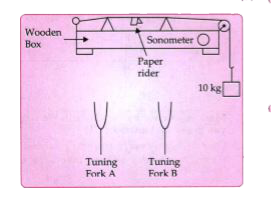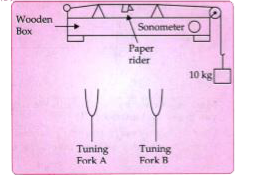The stem of a vibrating tuning fork is pressed against a table top.
Will it produce an audible sound ?
To determine whether the stem of a vibrating tuning fork pressed against a table top will produce an audible sound, we can follow these steps:
Step 1: Understand the Mechanism of Sound Production
When a tuning fork vibrates, it creates sound waves. These sound waves are produced due to the oscillation of the fork's prongs.
Hint: Remember that sound is generated by vibrations.
Step 2: Consider the Medium
When the tuning fork's stem is pressed against a table top, the vibrations from the tuning fork are transmitted through the solid material of the table. This is important because sound travels well through solids.
Hint: Think about how sound travels through different materials.
Step 3: Determine the Frequency of the Sound
Tuning forks are designed to produce sound at specific frequencies, typically within the audible range (20 Hz to 20 kHz). When the tuning fork vibrates, it will produce sound waves at its natural frequency.
Hint: Recall the range of frequencies that humans can hear.
Step 4: Assess the Audibility
Since the tuning fork vibrates at a frequency that falls within the audible range, and the vibrations are transmitted through the table, the sound produced will indeed be audible to the human ear.
Hint: Consider whether the frequency of the tuning fork is within the hearing range.
Conclusion
Yes, the stem of a vibrating tuning fork pressed against a table top will produce an audible sound. The vibrations are transmitted through the table, allowing us to hear the sound produced by the tuning fork.
---
When a tuning fork vibrates, it creates sound waves. These sound waves are produced due to the oscillation of the fork's prongs.
When the tuning fork's stem is pressed against a table top, the vibrations from the tuning fork are transmitted through the solid material of the table. This is important because sound travels well through solids.
Tuning forks are designed to produce sound at specific frequencies, typically within the audible range (20 Hz to 20 kHz). When the tuning fork vibrates, it will produce sound waves at its natural frequency.
Since the tuning fork vibrates at a frequency that falls within the audible range, and the vibrations are transmitted through the table, the sound produced will indeed be audible to the human ear.
Yes, the stem of a vibrating tuning fork pressed against a table top will produce an audible sound. The vibrations are transmitted through the table, allowing us to hear the sound produced by the tuning fork.
Topper's Solved these Questions
- SOUNDBook:ICSEChapter:SOUNDExercise:EXERCISE -7(A)
Explore 20 Videos
- SOUNDBook:ICSEChapter:SOUNDExercise:EXERCISE -7(A) (MULTIPLE CHOICE TYPE)
Explore 2 Videos
- SIMPLE MACHINES Book:ICSEChapter:SIMPLE MACHINES Exercise:DIAGRAM BASED MCQ
Explore 5 Videos
- SPECIMEN PAPER (SOLVED)Book:ICSEChapter:SPECIMEN PAPER (SOLVED)Exercise:SECTION II
Explore 78 Videos
Similar Questions
The stem of a vibrating tuning fork is pressed against a table top.
Does it cause the table top to set in vibrations ? If yes, what type of vibrations are they?
View SolutionThe stem of a vibrating tuning fork is pressed against a table top.
Under what condition does it lead to resonance ?
View SolutionWhen the stem of a vibrating tuning fork is gently pressed on the surface of a table louder sound is heard. Why?
View SolutionAssertion: A vibrating tuning fork sounds louder when its stem is pressed against a desk top.
Reason : When a wave reaches another denser medium, part of the wave is reflected.
View SolutionName the phenomenon that cause a loud sound when the stem of a vibration tuning fork is kept pressed on the surface of a table.
View SolutionWhen a tuning fork (vibrating) is held close to ear, one hears a faint hum. The same (vibrating tuning fork) is held such that its stem is in contact with the table surface, then one hears a loud sound. Explain.
View Solution
The diagram above shows a wire stretched over a sonometer. Stems of two vibrating tuning forks A and B are touched to the wooden box of the sonometer. It is observed that the paper rider (a small piece of paper folded at the centre) present on the wire flies off when the stem of vibrating tuning fork B is touched to the wooden box but the paper just vibrates when the stem of vibrating tuning fork A is touched to the wooden box.
Why does the paper rider fly off when the stem of tuning fork B is touched to the box ?
View SolutionThe diagram below shows a wire stretched over a sonometer. Stems of two vibrating tuning forks A and B are touched in turn to the wooden box of the sonometer. It is observed that the paper rider (a small piece of paper folded at the centre) present on the wire flies off when the stem of vibrating tuning fork B is touched to the wooden box but the paper just vibrates when the stem of vibrating tuning fork A is touched to the wooden box.

Name the phenomenon when the paper rider just vibrates.
View Solution
The diagram above shows a wire stretched over a sonometer. Stems of two vibrating tuning forks A and B are touched to the wooden box of the sonometer. It is observed that the paper rider (a small piece of paper folded at the centre) present on the wire flies off when the stem of vibrating tuning fork B is touched to the wooden box but the paper just vibrates when the stem of vibrating tuning fork A is touched to the wooden box.
Name the phenomenon when the paper rider flies off.
View SolutionHow does a stretched string on being set into vibration, produce the audible sound?
View Solution